Computer Programs & Asce 7-16 Method
MecaWind is a wind load calculator software used to calculate wind loads and/or wind pressures on the main wind force resisting system (MWFRS) of buildings and many other structures (Chimneys, Tanks, Towers, Open Signs, Closed Signs, Solar Panels, Rooftop Equipment, Canopy, Bins, Tanks, Silos and Free Standing Walls). It is based upon the ASCE 7 standard used throughout the United States for design loads, which is published by the American Society of Civil Engineers. The MecaWind wind load calculator software contains multiple versions of the ASCE 7 standard as well as the Florida Building Code (FBC). For instance, it includes, ASCE 7-05, ASCE 7-10 and ASCE 7-16 , each being a different release of the same standard. The latest version is ASCE 7-16, and many of the changes found from the ASCE 7-10 version to ASCE 7-16 can be found in this article. ASCE 7-05 is also included in MecaWind, but this older version of the standard is used less frequently in jurisdictions. However, having it included allows users to evaluate existing structures to the older version of the ASCE 7 standard. MecaWind software is very cost effective, easy to use, and has a minimal learning curve. The software allows you to perform wind design with ease and is essentially a wind pressure calculator.
MecaWind calculates wind loads per the ASCE 7 standard, and in that standard there are two basic classifications of structures:
- Buildings
- Other Structures
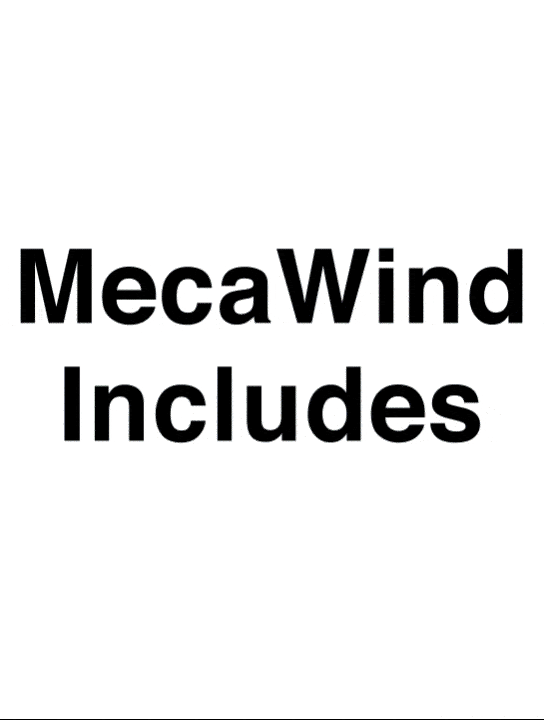
Buildings:
A building is just as you would expect, it could be a simple house or storage building or a high rise building. There are many different special classifications of buildings within the ASCE 7 standard, and all of these are covered by the MecaWind wind load calculator software. Below is a list of examples:
- Enclosed Building
- Partially Enclosed Building
- Partially Open Building
- Open Building
- Low Rise Building
- Simple Diaphragm Building
- High Rise Building
- L-Shaped Building
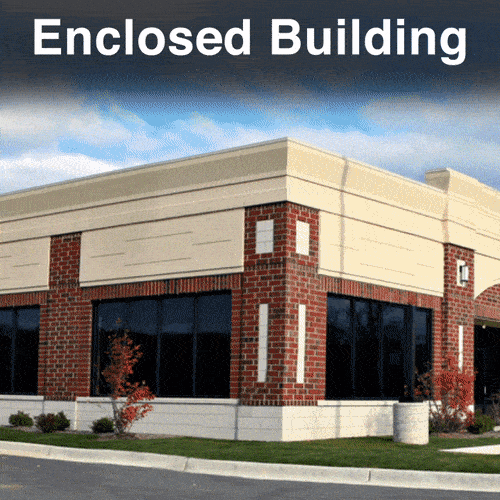
Roof Types:
There are several different roof types which are addressed in the ASCE 7 standard, and these same roof types are also included as options with the MecaWind wind load calculator software. Depending upon the specific analysis methods chosen, some of these roofs are not handled by ASCE 7. However, the MecaWind wind load calculator software makes it easy for the user to easily see which roofs are permissible based upon the method that has been selected by the user.
Here are some of the more commonly used roof types:
Arched, Domed, Flat, Stepped, Gabled, Multi-span Gabled, Hipped, Mansard, Monoslope and Sawtooth.

Overhang:
Many different types of buildings have overhangs, and the criteria in ASCE 7 on how to calculate wind pressures is cumbersome, to say the least. Depending upon whether the overhang has a soffit or not determines when the building internal pressure must be taken into account. Fortunately, MecaWind makes this process easy since it's all handled automatically once the overhang is modelled.
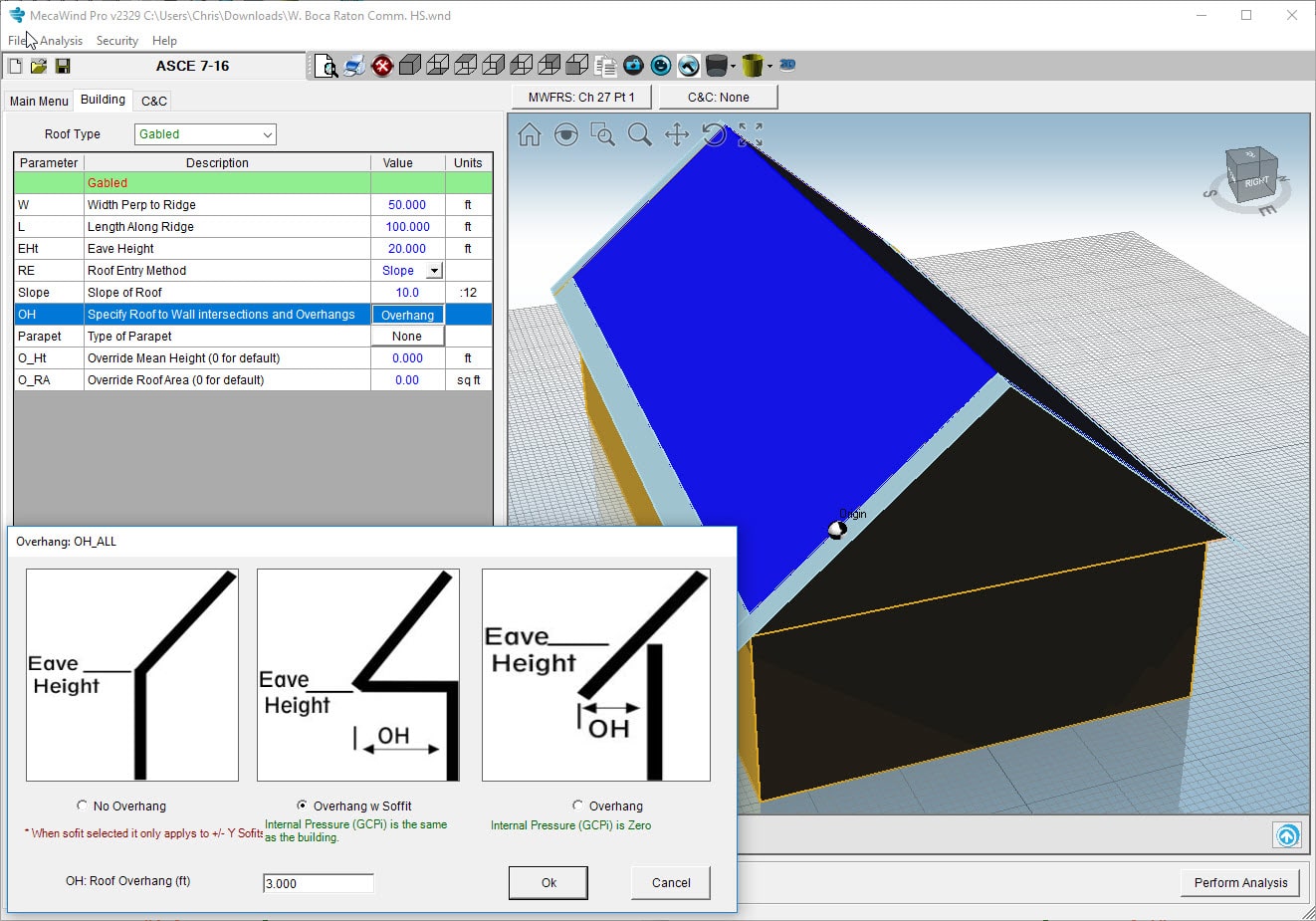
Parapet:
Parapets are very common in buildings, and the criteria in ASCE 7 on how to calculate wind pressures on parapets is anything but simple. Fortunately, MecaWind makes the process of calculating wind loads on parapets relatively simple. Enter the dimensions and porosity of the parapet, and then the wind pressure calculator will clearly display the results on all surfaces in the analysis output.
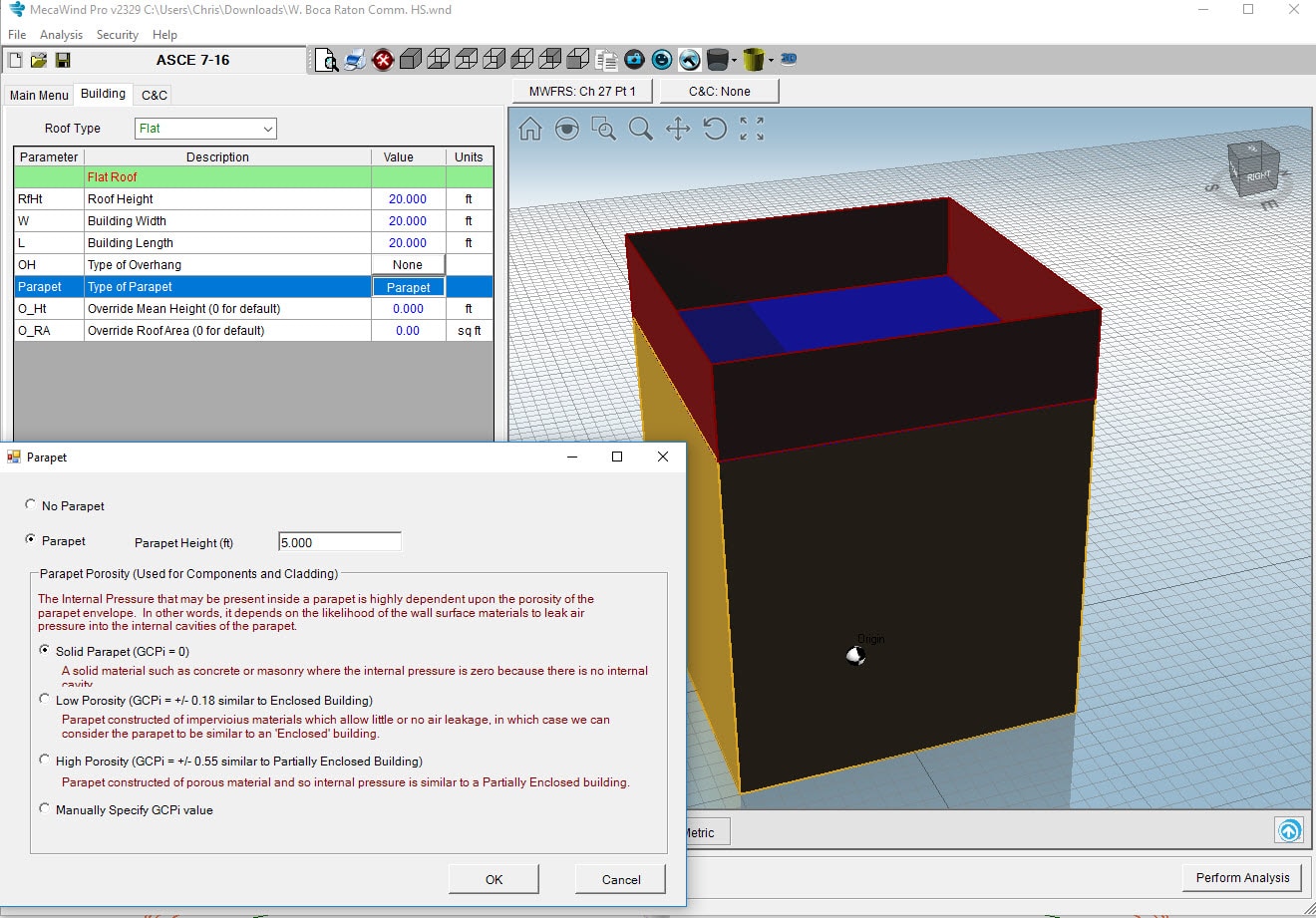
Main Wind Force Resisting System (MWFRS):
The Main Wind Force Resisting System (MWFRS) is the assemblage of structural elements that are assigned to provide support and stability for the overall building or other structure. The system generally receives wind loads from multiple surfaces.
For designers that are designing the MWFRS, you will need the wind pressures on all the surfaces of the building in order to get the overall load on the structural elements. ASCE 7 offers four (4) different methods to use when calculating the MWFRS. Two of these methods are based upon the "Directional Procedure" and the other two on the "Envelope Procedure". Can you use any of these four methods? The answer is no, you must meet the criteria specified for each method in order to use that procedure.
MecaWind has adopted a system based upon colors (Green = Good and Red = Bad), much like a traffic signal. The circles next to each method are either Red (Not valid) or Green (Valid) giving the user a quick overview of which methods can be used based on the structure parameters entered. Clicking on these circles then gives the color coded summary of what criteria has been met. Similarly, this follows the Green (Criteria met) and Red (Criteria Not met) basis. Any method that is Green can be selected, and the designer can easily compare the pressures and loads between the different methods.
This process is shown graphically below, or by viewing this video on our youtube channel.

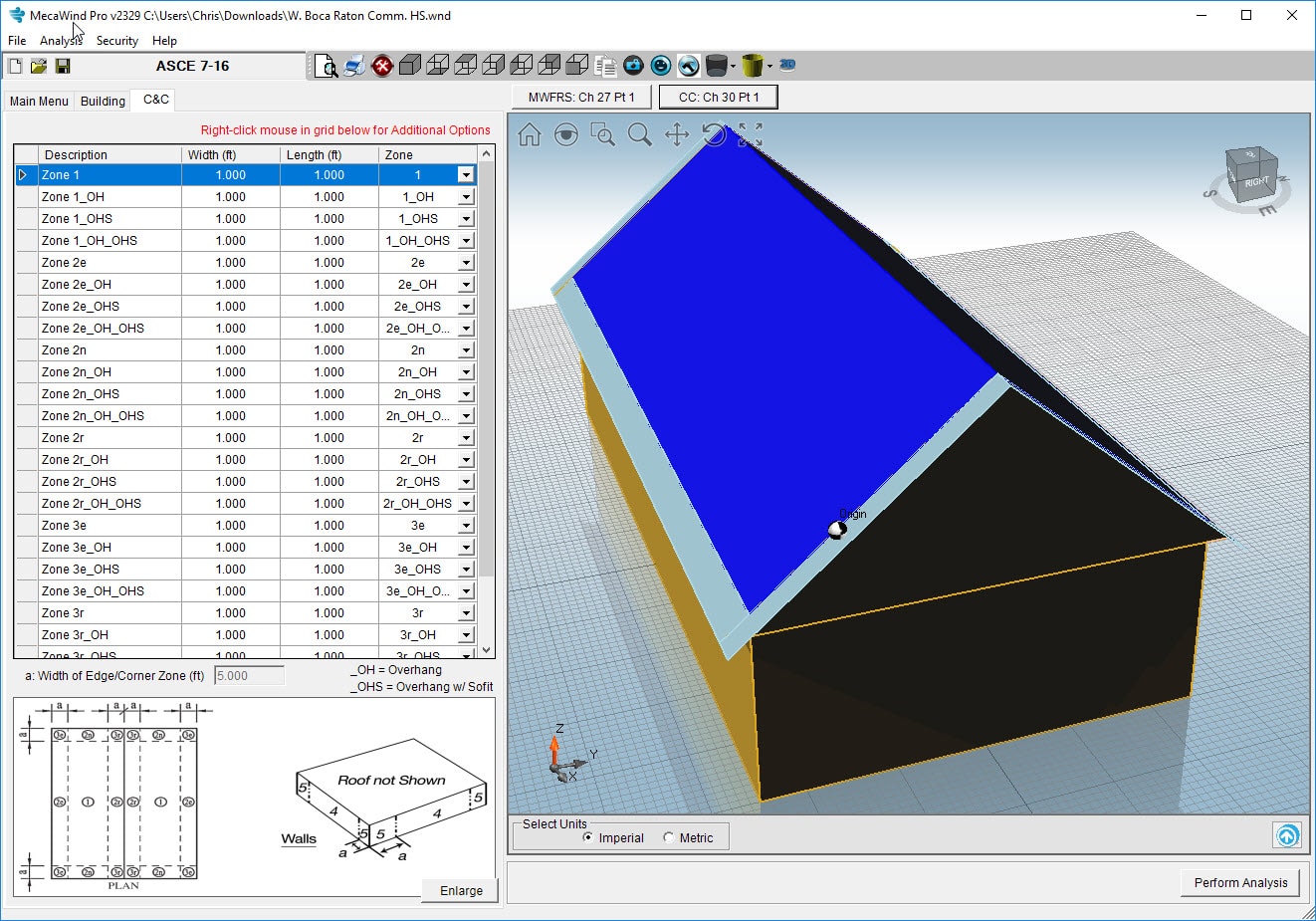
Components and Cladding (C&C):
ASCE 7 defines components and cladding (C&C) as elements of the building which do not qualify as part of the MWFRS. For example, this would consist of windows, doors, roof decking, fasteners, etc.. The user can enter as many different components and cladding items as they wish, or there is an option in MecaWind to allow you to auto-populate the list with one C&C element for each zone using the most conservative values. There is also an option to include a wind pressure summary for each C&C zone based on the effective wind areas in the specific zone.
ASCE 7 offers several methods to use for the wind pressure calculator on components and cladding. Similarly to the MWFRS procedure selection menu, MecaWind uses the same color basis for components and cladding method selection menu (Green = Good and Red = Bad). According to the parameters entered for the structure, certain methods will be available for use to the designer, and what criteria he is passing and failing for each of the C&C methods.

Other Structures:
Any structure which is not a building, is classified as an "Other Structure" by ASCE 7. This broad category includes many different types of structures and equipment.
- Chimneys & Stacks
- Tanks, Bins and Silos
- Towers
- Open & Solid Signs
- Solar Panels
- Canopy
- Free Standing Wall
- Rooftop Equipment
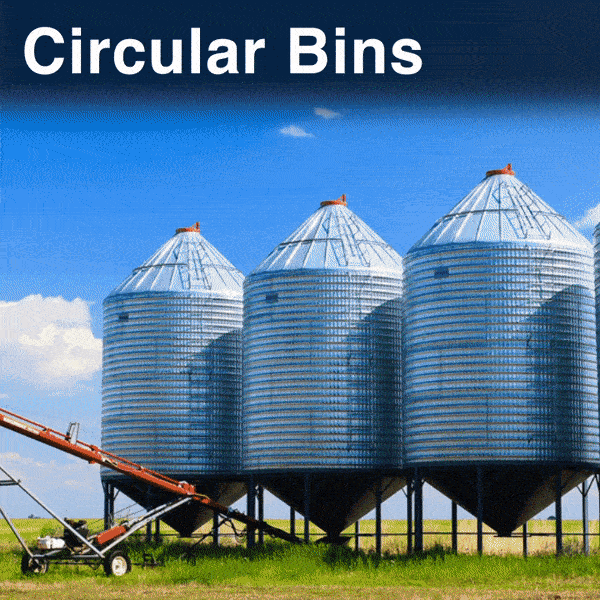
MecaWind Wind Load Software – Standard versus Pro Versions:
Here is a summary of the major differences between the Standard and Pro version.
MecaWind Standard Version:
MecaWind Standard version is the cost effective version of the program used by Engineers and Designers to a wind load calculator per ASCE 7-05, ASCE 7-10, ASCE 7-16, and FBC 2017. The program is simple to use, and offers a professional looking output with all necessary wind design calculations. The user also has a great deal of control at their fingertips to customize their output to suit their needs. This less expensive option will allow the designer to handle all of the basic calculations of wind pressures for Main Wind Force Resisting System (MWFRS) as well as Components and Cladding (C&C). See the table below for a detailed summary for what is included in the Standard version.
MecaWind Pro Version:
MecaWind Pro offers the same wind calculations as MecaWind Std, but with the added benefit of being able to graphically see all Main Wind Force Resisting System (MWFRS) pressures on each surface. Seeing the pressures graphically gives the user a real advantage at being able to visualize what is physically occurring to their structure. The user can turn on/off different surfaces, change colors, or rotate and manipulate the graphic just as you could in any 3D modeling package. In addition you can toggle between Wind Direction, +/- Internal Building Pressures, and Minimum Wind Pressures with ease.

You may then make a one (1) page report of this MWFRS Graphic with the click of a button. Here is an example of the one page summary that you can create.The adjustable graphical representation of the pressure vectors allows the user to change the size and density of the vectors, and you have complete control over which pressures are displayed and the colors. This gives the user all of the flexibility to customize the graphic to suit the needs of the designer.
In addition, MecaWind Pro offers the ability to calculate the total reactions at the base of the structure. This is no simple calculation, given the complexity of the pressure distributions on the roof. MecaWind Pro takes all pressures into account and gives a simple summary of the base reactions. The software adds the forces and moments about the origin of the building and summarizes those in the output.
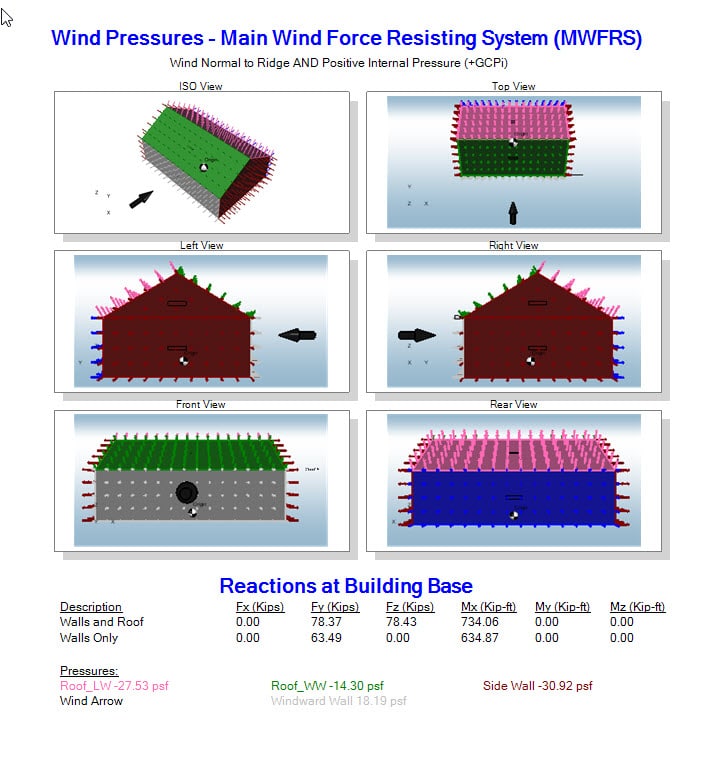
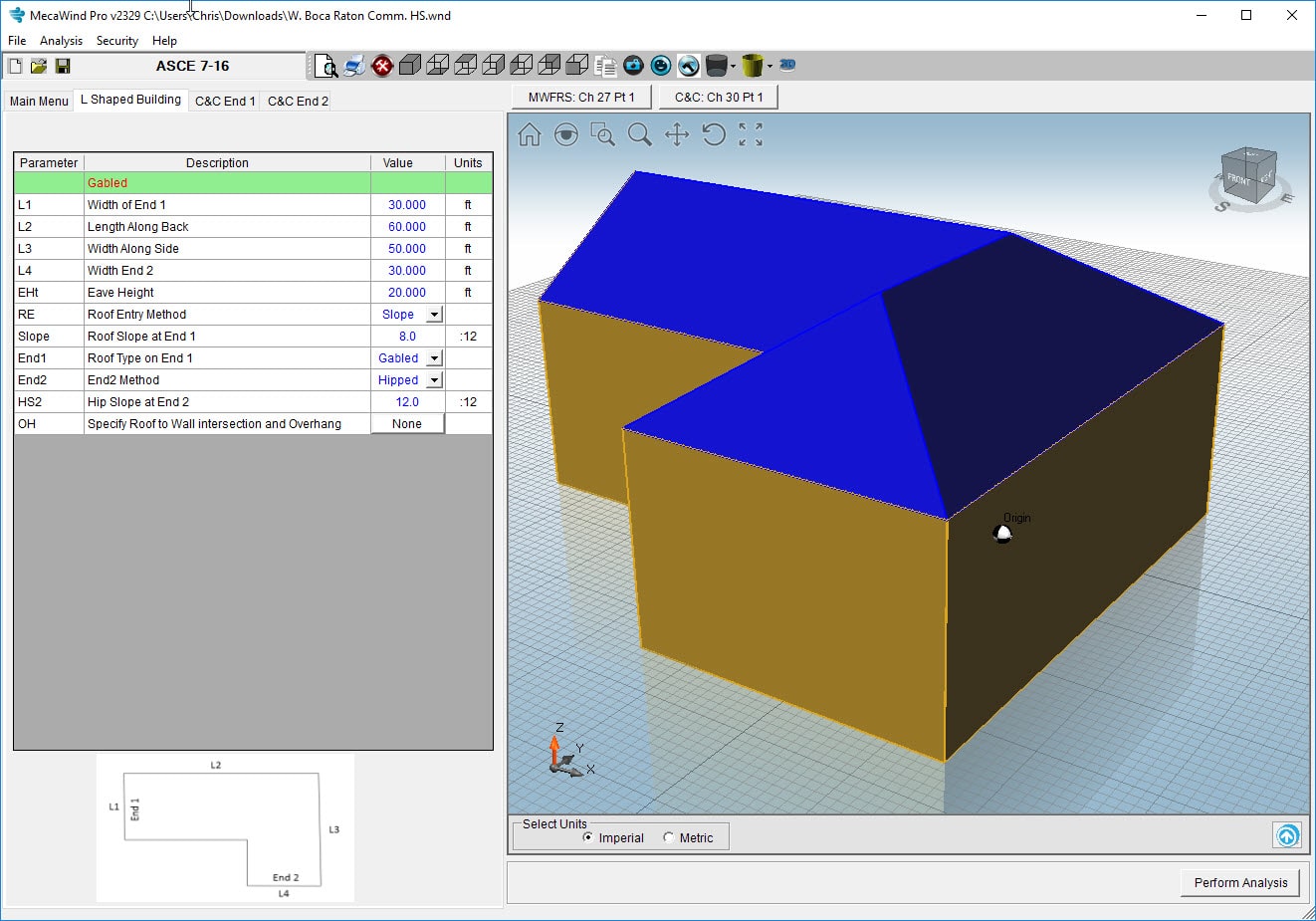
L-Shaped Buildings (Pro Only):
The Pro Version of MecaWind offers a template specifically for a wind load calculator on L-Shaped buildings. Although it is possible to model an L-Shaped building using the Standard version, it is not a simple process and would require multiple input files to simulate the L-Shaped building. The Pro version makes the L-Shaped building easy, with just a few simple inputs the entire analysis is performed by the MecaWind software.
If you need any help on which MecaWind software version you need, then fill out the form below to receive an email with a recommendation for the version of the software that would best meet your needs based on the parameters you entered.
Which MecaWind version do I need?
MecaWind Wind Load Software Version Comparison
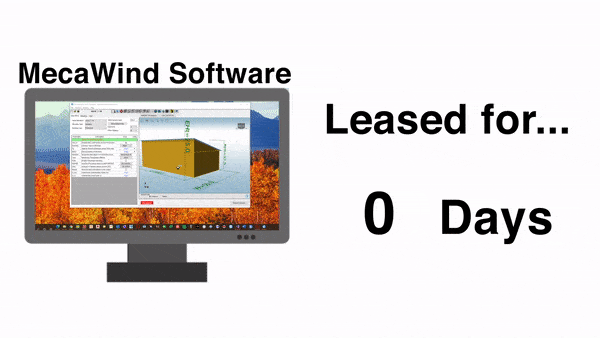

FREQUENTLY ASKED QUESTIONS:
Can I get a fully functioning demo to try out the software?
We offer a limited capability demo's, but we do not offer a fully functioning demo.
Does the program have a help manual?
A help manual is provided with the program in the form of a pdf file. You may print the file or view it electronically.
Is technical support available for the software?
Yes, technical support is available. We offer a very affordable program, and we are a lean company. This means that we must handle technical support by email . We request that questions be limited to the use of the software, we can not provide interpretations as to how to apply the code to various situations. There is an option under the "Help" menu which automatically emails the input file to Meca, and you simply provide an explanation to the problem which you are experiencing.
How quickly can I begin using the software?
Our order process is completely automated. If you purchase online, you will automatically receive an email with instructions on downloading and activating the software. This information also appears on the last page of the order process. You will be using the software in minutes after purchase.
Does it meet State Codes (FL, HI, etc..)?
Any state using ASCE 7-05, ASCE 7-10 or ASCE 7-16. It's difficult to keep up with all state requirements, but as far as we know all states are now following ASCE 7. Specific states that we know reference ASCE 7 include: California, Texas, Oklahoma, North Carolina, Hawaii. (If you know other states that should be added, let us know and we will add it). Please note that we do not include any "special provisions" that might exist in local codes, we only follow ASCE 7 in the software with the exception of the FBC 2017 code.
What is the latest version of the ASCE 7 Standard?
The latest version is ASCE 7-16 and it is incorporated into the MecaWind software.
I'm not an Engineer, is the software going to be difficult to learn?
The software itself is fairly simple to use; however, the program follows the ASCE 7 standard, and honestly it is not always a simple standard to follow. You probably already know this, and that's why you are looking to purchase software. The ASCE 7 standard uses a lot of terminology and has a lot of notes and special exceptions. The software helps navigate through those issues, but it still requires some familiarity with the ASCE 7 standard.
Do I need a copy of the ASCE 7-10 or ASCE 7-16 standard?
We recommend that the user has a copy of the standard.
Does the program come with a tutorial?
We have some videos which can be beneficial on our YouTube channel.
You can also purchase our EBook which is a great tool to explain wind load calculations and how to use the software to calculate wind loads.
Does the software handle oddly shaped buildings (T, L, U, etc..)?
MecaWind Pro handles L-Shaped buildings; however, for other unique buildings (T, U, etc..) these shapes can be handled by making multiple analysis runs of the software. There is an example of how to do this in the Ebook that we offer
REFUND POLICY:
Refunds must occur within 72 hours of purchase and for any time after which store credit will be considered on a case by case basis. The customer will need to email [email protected] with their refund request with proof of purchase attached.
Computer Programs & Asce 7-16 Method
Source: https://www.mecaenterprises.com/mecawind-software/

0 Response to "Computer Programs & Asce 7-16 Method"
Post a Comment